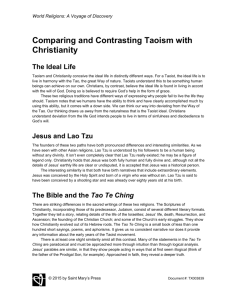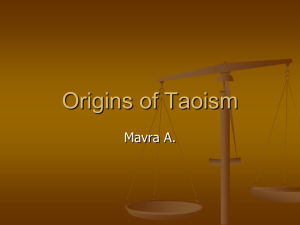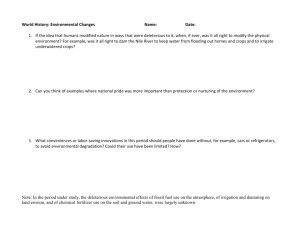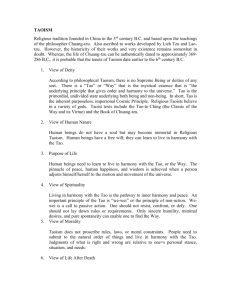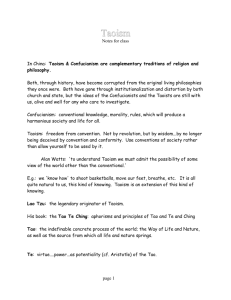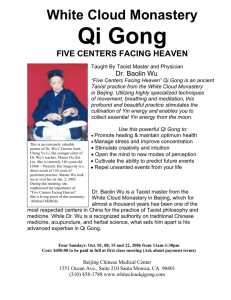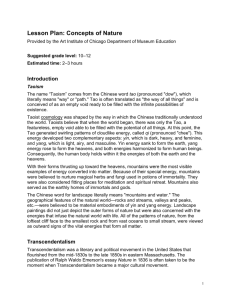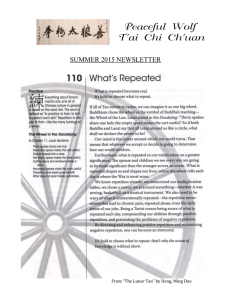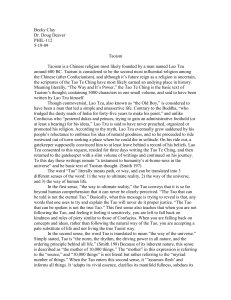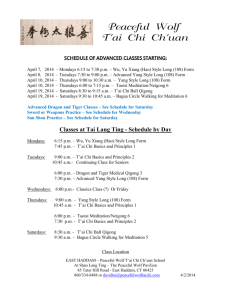History of Taoism - Mr.Bye Social Studies
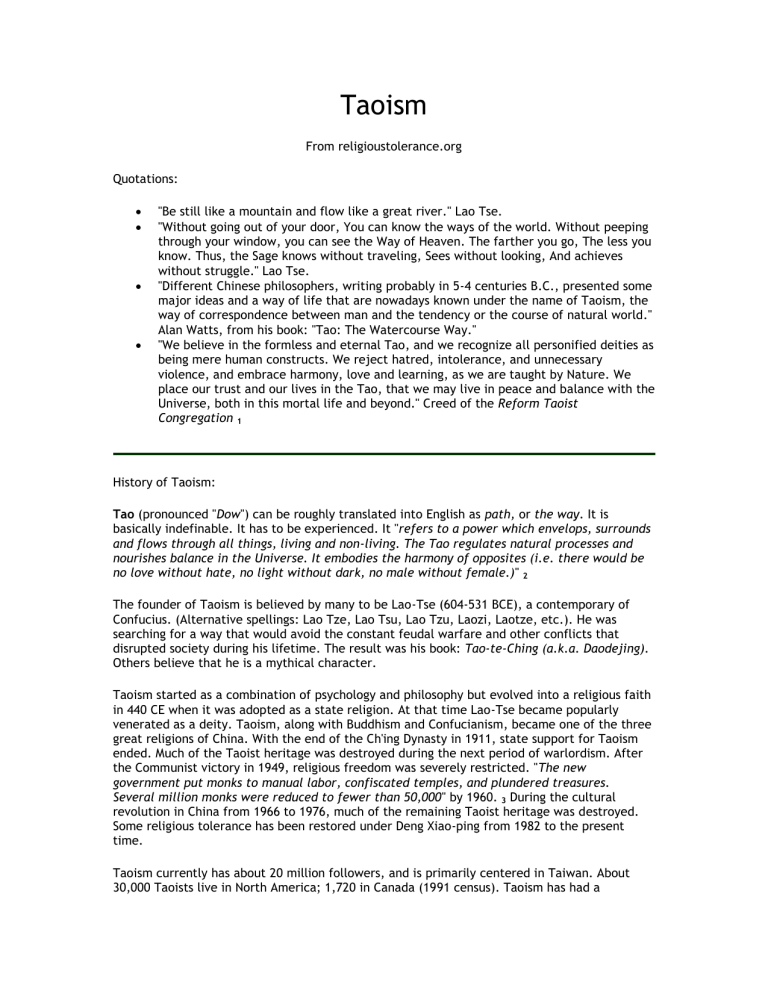
Taoism
From religioustolerance.org
Quotations:
"Be still like a mountain and flow like a great river." Lao Tse.
"Without going out of your door, You can know the ways of the world. Without peeping through your window, you can see the Way of Heaven. The farther you go, The less you know. Thus, the Sage knows without traveling, Sees without looking, And achieves without struggle." Lao Tse.
"Different Chinese philosophers, writing probably in 5-4 centuries B.C., presented some major ideas and a way of life that are nowadays known under the name of Taoism, the way of correspondence between man and the tendency or the course of natural world."
Alan Watts, from his book: "Tao: The Watercourse Way."
"We believe in the formless and eternal Tao, and we recognize all personified deities as being mere human constructs. We reject hatred, intolerance, and unnecessary violence, and embrace harmony, love and learning, as we are taught by Nature. We place our trust and our lives in the Tao, that we may live in peace and balance with the
Universe, both in this mortal life and beyond." Creed of the Reform Taoist
Congregation
1
History of Taoism:
Tao (pronounced "Dow") can be roughly translated into English as path, or the way. It is basically indefinable. It has to be experienced. It "refers to a power which envelops, surrounds and flows through all things, living and non-living. The Tao regulates natural processes and nourishes balance in the Universe. It embodies the harmony of opposites (i.e. there would be
no love without hate, no light without dark, no male without female.)"
2
The founder of Taoism is believed by many to be Lao-Tse (604-531 BCE), a contemporary of
Confucius. (Alternative spellings: Lao Tze, Lao Tsu, Lao Tzu, Laozi, Laotze, etc.). He was searching for a way that would avoid the constant feudal warfare and other conflicts that disrupted society during his lifetime. The result was his book: Tao-te-Ching (a.k.a. Daodejing).
Others believe that he is a mythical character.
Taoism started as a combination of psychology and philosophy but evolved into a religious faith in 440 CE when it was adopted as a state religion. At that time Lao-Tse became popularly venerated as a deity. Taoism, along with Buddhism and Confucianism, became one of the three great religions of China. With the end of the Ch'ing Dynasty in 1911, state support for Taoism ended. Much of the Taoist heritage was destroyed during the next period of warlordism. After the Communist victory in 1949, religious freedom was severely restricted. "The new government put monks to manual labor, confiscated temples, and plundered treasures.
Several million monks were reduced to fewer than 50,000" by 1960.
3
During the cultural revolution in China from 1966 to 1976, much of the remaining Taoist heritage was destroyed.
Some religious tolerance has been restored under Deng Xiao-ping from 1982 to the present time.
Taoism currently has about 20 million followers, and is primarily centered in Taiwan. About
30,000 Taoists live in North America; 1,720 in Canada (1991 census). Taoism has had a
significant impact on North American culture in areas of "acupuncture, herbalism, holistic
medicine, meditation and martial arts..."
3
Taoist concepts, beliefs and practices:
Tao is the first-cause of the universe. It is a force that flows through all life.
"The Tao surrounds everyone and therefore everyone must listen to find
enlightenment."
4
Each believer's goal is to harmonize themselves with the Tao.
Taoism has provided an alternative to the Confucian tradition in China. The two traditions have coexisted in the country, region, and generally within the same individual.
The priesthood views the many gods as manifestations of the one Dao, "which could not
be represented as an image or a particular thing." The concept of a personified deity is foreign to them, as is the concept of the creation of the universe. Thus, they do not pray as Christians do; there is no God to hear the prayers or to act upon them. They seek answers to life's problems through inner meditation and outer observation.
In contrast with the beliefs and practices of the priesthood, most of the laity have
"believed that spirits pervaded nature...The gods in heaven acted like and were treated like the officials in the world of men; worshipping the gods was a kind of rehearsal of attitudes toward secular authorities. On the other hand, the demons and ghosts of hell acted like and were treated like the bullies, outlaws, and threatening strangers in the real world; they were bribed by the people and were ritually arrested
by the martial forces of the spirit officials."
3
Time is cyclical, not linear as in Western thinking.
Taoists strongly promote health and vitality.
Five main organs and orifices of the body correspond to the five parts of the sky: water, fire, wood, metal and earth.
Each person must nurture the Ch'i (air, breath) that has been given to them.
Development of virtue is one's chief task. The Three Jewels to be sought are compassion, moderation and humility.
Taoists follow the art of "wu wei," which is to let nature take its course. For example, one should allow a river to flow towards the sea unimpeded; do not erect a dam which would interfere with its natural flow.
One should plan in advance and consider carefully each action before making it.
A Taoists is kind to other individuals, in part because such an action tends to be reciprocated.
Taoists believe that "people are compassionate by nature...left to their own devices
[they] will show this compassion without expecting a reward."
5
The Yin Yang symbol:
This is a well known Taoist symbol. "It represents the balance of opposites in the universe.
When they are equally present, all is calm. When one is outweighed by the other, there is
confusion and disarray."
4
One source explains that it was derived from astronomical observations which recorded the shadow of the sun throughout a full year.
5
The two swirling shapes inside the symbol give the impression of change -- the only constant factor in the
universe. One tradition states that Yin (or Ying; the dark side) represents the breath that formed the earth. Yang (the light side) symbolizes the breath that formed the heavens.
One source states: "The most traditional view is that 'yin' represents aspects of the feminine: being soft, cool, calm, introspective, and healing... and "yang" the masculine: being hard, hot, energetic, moving, and sometimes aggressive. Another view has the 'yin' representing night and 'yang' day.
5
Another source offers a different definition: A common misconception in the west is that "...yin is soft and passive and yang is hard and energetic. Really it is yang that is soft and yin that is hard, this is because yang is energetic and yin is passive. Yin is like a rock and yang is like
water or air, rock is heavy and hard and air is soft and energetic."
8
Allan Watts, describes the yin and yang as negative and positive energy poles: "The ideograms indicate the sunny and shady sides of a hill....They are associated with the masculine and the feminine, the firm and the yielding, the strong and the weak, the light and the dark, the rising and the falling, heaven and earth, and they are even recognized in such everyday
matters as cooking as the spicy and the bland."
9,10
However, since nothing in nature is purely black or purely white, the symbol includes a small black spot in the white swirl, and a corresponding white spot in the black swirl.
Ultimately, the 'yin' and 'yang' can symbolize any two polarized forces in nature. Taosts believe that humans often intervene in nature and upset the balance of Yin and Yang.
About the name: Taoism or Daoism:
There are two commonly used systems for translating the Mandarin Chinese language into
Roman letters:
Wade-Giles: This system is commonly used in Taiwan and the U.S. The Chinese character for "Way" becomes "Tao," which leads to the English word "Taoism."
Hanyu pinyin or Pinyin: This system was developed by the Chinese people and is now finding increased use worldwide. The "Way" becomes "Dao," which leads to the English word "Daoism." The "Dao" is pronounced like the "Dow" in "Dow-Jones Index."
We have chosen to emphasize the "Taoism" spelling. A Google search for "Taoism" returned
245,000 hits, whereas a search for "Daoism" returned only 35,000.
Tai Chi:
There is a long history of involvement by Taoists in various exercise and movement techniques.
6
Tai chi in particular works on all parts of the body. It "stimulates the central nervous system, lowers blood pressure, relieves stress and gently tones muscles without strain. It also enhances digestion, elimination of wastes and the circulation of blood. Moreover, tai chi's
rhythmic movements massage the internal organs and improve their functionality." Traditional
Chinese medicine teaches that illness is caused by blockages or lack of balance in the body's
"chi" (intrinsic energy). Tai Chi is believed to balance this energy flow.
Taoist Texts:
These include:
Tao-te-Ching ("The Way of Power," or "The Book of the Way") is believed to have been written by Lao-Tse. It describes the nature of life, the way to peace and how a ruler should lead his life.
Chuang-tzu (named after its author) contains additional teachings.
Taoist web sites:
Taoist course, books and objects: o Lao Tzu and Taoism Revealed: A 40-day course delivered by email. You may learn more about the life and philosophy of Lao Tzu, including the study of Tao
Te Ching, and concepts like tao, wu-wei, wu, and more. Register here. More information o The LaoZi Academy in Sydney, Australia, teaches "... the fundamentals and secrets of ancient Daoist life. The Academy delivers clear and concise principles and practice methods used by ancient Daoist masters in the pursuit of health, happiness and longevity many thousands of years ago." See: http://www.laoziacademy.com/ o MoreLight.net publishes a number of books from the Taoist canon, including
The Primordial Breath, Volumes 1 & 2, and Oneirocritica (The Interpretation of
Dreams). See: http://morelight.net/ o Mr. Sage's Philosophical Taoist Homepage's intent is to give a more scientific, astro-physics, philosophical, as well as traditional esoteric view on Taoism.
See: http://members.aol.com/ o Sacred Mountain Press publishes Taoist works. Their "... goal is to make interesting, beautiful, and reliable Taoist information as accessible to the
general public as that of any other major religious or spiritual tradition." See: http://www.smpress.com o "Tao Resource" is a web site that imports authentic Taoist products to help people improve their "personal or sacred space, to build a small Taoist shrine
or even to construct a large Taoist temple." This site is well worth perusing. It has sections showing altar tables, bells & chimes, jewelry, statuary, personal altars, etc. See http://www.taoresource.com/
Tai Chi: o "Is Tai Chi the Ultimate Exercise?," an essay on Tai Chi at: http://www.utah.edu/ o "The International Taoist Tai Chi Society"
®
is the largest non-profit Tai Chi group in the world. See: http://www.taoist.org
